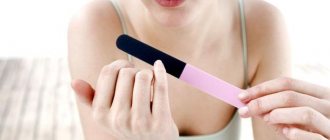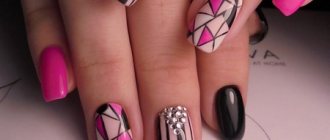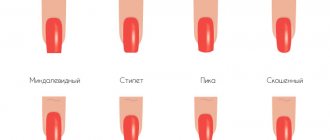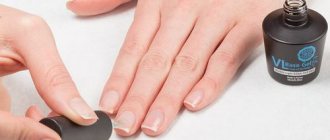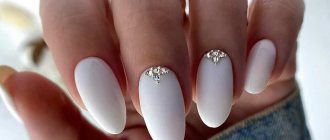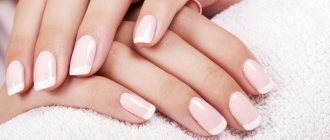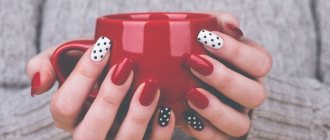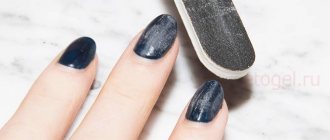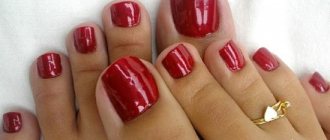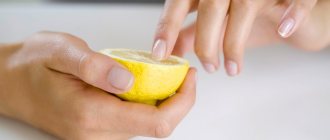What is acrygel?
Acrigel for nail extensions is called polygel, combigel and acrylic. Regardless of what name the product has, it is one composition that combines the excellent characteristics of acrylic powder, designed to lengthen the plates, and gel.
The product borrows plasticity from the gel system, and reliability from the acrylic system. Therefore, the maximum effect was achieved, which exceeded expectations.
The composition has a thick and viscous texture, vaguely reminiscent of plasticine. May be contained in tubes and jars. Due to its plasticity, the gel does not spread, which eliminates contact with the skin. In this regard, it is pleasant and quite easy to work with when strengthening and lengthening nails.
Due to the components included in the composition, acrygel allows you to perform the following procedures:
- restore damaged plates;
- mask chips that are present on extended and natural nails;
- align the trapezoidal nail plate;
- strengthen the nail plate.
A huge advantage is that Combigel is completely odorless and safe in contact with skin. In this regard, it is well suited for those who have an allergic reaction to such materials.
Acrigel does not harden in air; it is permissible to work with it in slow mode. This is especially comfortable for those who are just learning manicure skills.
The product has an affordable price, which has made it a leader among formulations designed to lengthen the shape.
To extend the plate, you must have the following specific list of inventory and materials:
- lint-free wipes;
- liquid for soaking the brush;
- brushes for shaping;
- a lamp designed for drying combigel;
- degreaser;
- files necessary for correcting, polishing and grinding extended nails;
- primer;
- tips or forms;
- a top that allows you to do without using a base.
The list does not include the ingredients needed to create a manicure, since they are very different from the method of getting rid of cuticles.
Main characteristics of the coating
Acrigel for nail extensions is easily bonded to the plate due to the applied primer, without the need to use a base. The use of the base is permitted, but it is not considered a prerequisite.
The characteristics of working with acrygel are shown in the following list:
- When drying in the lamp, there is no burning sensation at all, which is very convenient for a client who has sensitive nails.
- The sun's rays do not affect the result, since the composition dries only under ultraviolet lamps. To dry white acrylics, it is recommended to use a high-power lamp.
- Apply the gel with a brush pre-impregnated with clinser. Due to this, the product does not stretch, but is easily leveled and retains its shape upon completion of application. Thanks to this property, the nail plate can be given almost any shape that does not require filing.
- The advantage is the safe environment of the gel relative to the skin, especially those that are prone to allergic reactions. When covering the nail plate, streaks on the cuticle and side ridges are completely eliminated due to the unique structure of the composition. When working, the main thing is to use a high-quality cleanser, which, when in contact with the nail or skin, will be safe and will not dry out the skin.
- When laying out and leveling the acrygel, it does not harden upon contact with air. The product can be applied to the nail at any time and, if there is not enough of it, the limits of this action will not be visible.
- At the time of filing, dust does not spread in the air, but immediately settles, since most of its particles are heavier, unlike acrylic and gel by 30%.
By lengthening nails with acrylic, you can get stronger and more flexible nails that are very resistant to breaks and external loads. This allows, with sufficiently beautiful shapes, to achieve a reliable and durable coating of the required length.
The weight of the composition is almost unnoticeable after application, since it is much lighter than acrylic or gel. Due to the adhesive properties of the material, its detachment from the nail plate is practically eliminated, and the final result will be as natural as possible, both in shade and shape.
How does acrygel differ from other types of materials?
Acrigel for nail extensions makes it possible to achieve maximum effect in comparison with standard formulations. It can be applied in a very thin layer than acrylic. Ultimately, the nails look more natural.
Compared to acrylic, acrylic will not harden under a lamp without drying. Due to this, it is easier to work with it and the time period for carrying out the procedure is reduced.
Acrigel remains in one area and does not spread, unlike gel polish. Thanks to this, you can experiment with different shapes and use it when modeling the upper nail forms. The use of gel allows specialists to save money, since the consumption of the composition is minimal.
Polygel what is it
Polygel nail extension
Poly gel nails is a new technology that uses a composition that combines the properties of gel polish and acrylic. It is particularly reliable and stays on the nails until it is time to make a correction to hide the regrowth. At the same time, the polygel does not damage the nail plate, as happens when using acrylic.
Applying acrylic gel to the nail
The composition differs from gel polish in consistency: it is thick and does not spread when applied.
Acrylatic has a number of other important advantages:
- Does not have a pungent odor. You no longer have to open all the windows wide and suffer from the chemical “amber” that causes headaches. In addition, when working with polygel, you will not have to suffer from the ubiquitous dust. The composition is heavier than acrylic, and its particles settle almost immediately without floating in the air;
- With high strength, the polygel coating looks neat and natural, due to the fact that it is not applied in such thick layers as acrylic;
- The composition does not harden without drying under a UV lamp, which means there is no need to rush with modeling. You can add polygel to your nails until there is enough of it. In this case, unevenness will not appear, and the coating will be uniform;
- The use of a special liquid, a clinser, when working with acrylics makes the application process extremely simple. The composition does not spread, does not harden, lays down evenly and is well distributed with a brush;
- Since streaks are excluded, the skin around the nail will not suffer from the aggressive effects of the composition. This is especially important for girls prone to allergic reactions. Another plus for those with delicate hands is the absence of burning when drying under the lamp;
- After application, the coating almost does not need to be filed, especially since it can be easily removed using a router or file. This flexibility allows you to achieve the ideal shape;
- A thin layer of combigel does not weigh down the nails; high adhesive properties allow you not to worry about the integrity of the coating.
Perhaps the only disadvantage of polygel is the very small selection of colors. The palette of produced materials consists only of shades that are as close as possible to natural ones. If desired, you can apply a layer of bright gel polish on top of the coating, and an impressive manicure is ready.
Pros and cons of acrygel
Acrigel intended for nail extensions has both positive and negative sides.
Before carrying out the procedure, it is recommended to familiarize yourself with all its features:
| Advantages | Flaws |
|
|
It is not recommended to wear artificial nails on a regular basis, since the natural plate needs to rest and breathe. To strengthen and treat the plate, it is advisable to use vitamins and use proper nutrition.
Technology of applying acrygel to nails and features of use
Acrigel for nail extensions requires a manicure with preliminary treatment of the cuticle.
To lengthen your nail bed using gel, it is recommended to follow these steps:
- It is necessary to remove the glossy shine from the surface of a natural plate using a buff and remove dust. Then you need to place the extension forms. Afterwards the surface should be degreased.
- The nail plate must be covered with a primer without touching the skin. Due to this, the composition will better adhere to the surface, and you will not have to use a base layer.
- The brush needs to be soaked in liquid. This procedure must be repeated at the stage of laying out the material. This is required so that the gel does not get clogged into the bristles of the brush.
- The acrygel ball must be transferred to the nail plate. Using pressing movements of the brush, you should distribute the material over the surface of the plate and to the required length according to the shape. Near the cuticle, the layer of gel should be thin, since this area of the plate is more susceptible to detachments.
- Afterwards, the nail needs to be dried in a lamp. For LED it will take about 1 minute, for ultraviolet about 2 minutes.
- To strengthen the stress zone, you need to re-apply an acrygel ball to the nail. Then again you need to apply a small ball of gel, placing it on the surface of the plate for leveling. Next, the material needs to be dried in a lamp.
- After drying, you will need to remove the sticky layer and make a sawdust, achieving the desired shape.
- At the end, the surface can be covered with a topcoat or a design can be made.
This algorithm is considered basic, it will differ in the type of lengthening: for lower or upper forms, tips, a French manicure or standard strengthening without lengthening is required.
A popular procedure is to extend the upper forms as they are very easy to model and require little filing. When strengthening, you do not need to use forms. It is only permissible to lengthen the nail bed by a small amount and change the shape of the free edge.
Acrigel has few shades. Polygels are often available for sale in camouflage or to match the color of the natural plate. The design is carried out on top of the modeled nail with gel polish. The material can be mixed with colored gel to obtain acrygel with a tint.
How to use acrylic correctly
Strengthening nails with gel
If we are talking about nail extensions, then you can work with both top forms and tips. The main thing to do is a regular clean manicure followed by dehydration. An acid-free primer is applied to the prepared nails.
Extensions on top forms with acrylic
How to extend short nails with polygel step by step:
- Forms are applied to the prepared nail plates. If necessary, apply a layer of base coat.
- The brush is moistened in a cleanser so that the bristles are damp, but not dripping.
- You need to take a little acrygel from the tube and put it on the nail using a spatula.
- Next, the composition is distributed over the plate in a thin layer. First, the brush moves towards the cuticle (there is no need to push acrylic under it), then towards the nail folds, and then towards the edge of the form. You need to carefully distribute the polygel, reducing it to almost zero at the edges.
- If there is not enough material, you can add more until you get a thin, neat layer that completely covers the mold.
- The nail is dried in a diode lamp for about 30 seconds. The mold is then removed and the nail is clamped to form an arch.
- A clip for extension is put on the plate, and the nail is dried again for half a minute under the lamp.
- A 140-240 grit file produces sawdust without applying too much pressure.
- The nail is treated with a buff for perfect smoothness.
- Finally, all that remains is to apply top coat or gel polish.
Strengthening nails
Strengthening your nails with Combigel is also not difficult; even a beginner who is starting to learn the basics of nail art can handle it.
How to strengthen nails with acrylic:
- A clean manicure is being performed. If necessary, wipe the marigolds with a dehydrator.
- You don’t need to apply the primer on dry nails; apply it in a very thin layer on wet nails.
- After a minute, it’s time to apply the base and dry the nails in the lamp.
- Moisten the brush in a special liquid, apply the composition to the nail as for extensions.
- Distribute acrygel to strengthen nails, starting from the cuticle and ending with the free edge of the plate. It is necessary to reduce the layer to almost zero. In this case, the excess that collects at the edge of the nail can be removed; if the composition does not stretch well, moisten the brush in the liquid.
- Having collected more clinser on the brush, the polygel layer is leveled, removing unnecessary roughness and unevenness.
- Dry the marigolds under a UV lamp. This will take 2 minutes.
- File off the excess using a 180-240 grit file and buff it.
- If a natural nude shade is suitable, you can apply a transparent top. Provided that the design should be bright, the nails are covered with gel polish.
Applying gel polish to polygel
Note! You can use any topcoat that is convenient to apply, or purchase a special base for polygel.
Nail repair with polygel
The procedure for repairing damaged natural nails is similar to the step-by-step instructions for strengthening them with polygel.
How to repair nails with acrylic gel:
- The first step, as always, is to tidy up your nails and clean them.
- A base is applied to the plates.
- Using a spatula, place an acrygel ball on the nails.
- The brush is slightly moistened with clinser.
- The polygel is distributed over the nail with gentle movements.
- The coating polymerizes under the lamp for 1.5 minutes.
- The shape is filed using a file (maximum 180 grit).
- Finally, a base is applied to the nails.
How to replace liquid for polygel
As a rule, a special construction fluid is used to work with polygel. No less often, a clinser is used for this purpose.
The liquid can be produced by any company; this does not affect compatibility with acrylic. There are times when the constructing composition is not at hand at all. Then you have to look for a replacement for a special liquid among household chemicals.
Liquid for working with acrylics
The simplest solution to the problem is to use regular alcohol. It is capable of softening the composition no worse than the constructive substance. However, professionals do not recommend replacing the original liquid with anything, because using third-party compounds can reduce the level of durability and ductility of acrygel.
In addition, alcohol will greatly dry out the skin around the nail, and with repeated use it will also damage the brush.
How to remove acrylic nails
To prevent disruption of the natural growth process of the nail plate, it is recommended to remove the material after 3 weeks.
To remove acrylic nails yourself, it is recommended to use the following instructions:
- It is necessary to cut the long shape. Next, cotton pads soaked in acrygel solvent should be applied to the surface of the plate. Before this, the cuticle will need to be coated with Vaseline.
- Each nail needs to be wrapped in foil for about 20 minutes. Due to this, the liquid will not evaporate and the heat that is required to activate the chemical reaction will be retained.
- Afterwards you need to remove the foil and remove the coating using orange sticks. If the material remains on the surface, the procedure must be repeated again after 10 minutes.
- Then the nails must be polished with a buff and impregnated with strengthening enamel.
- It is recommended to moisturize the fingernails with cream or oil.
This method of removing acrylic nails is possible at home, but it is advisable to carry out the procedure in salons where the gel was applied.
How to remove polygel from nails
You can remove the coating using a 160-200 grit file or a manicure cutter. Soaking a persistent composition in any liquids is useless; in addition, it can easily damage your nails.
Acrylic Removal
Even a beginner can figure out how to use poly gel nails. The process of working with the material is simple, and the result will be better than when using other types of coating. Strengthening nails, repairing with polygel and extensions - with this composition everything is possible.
